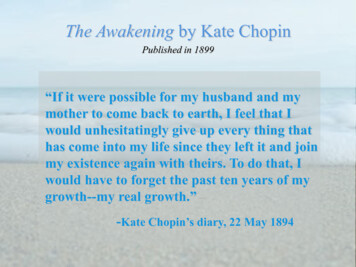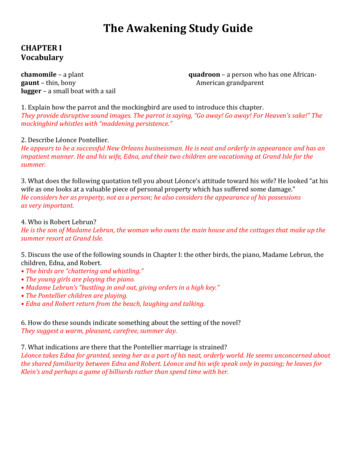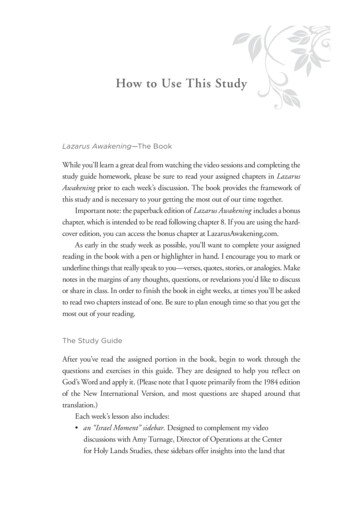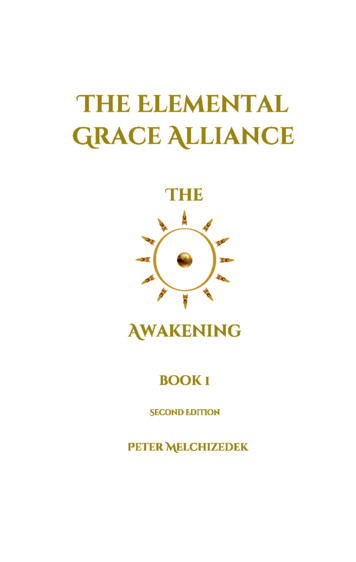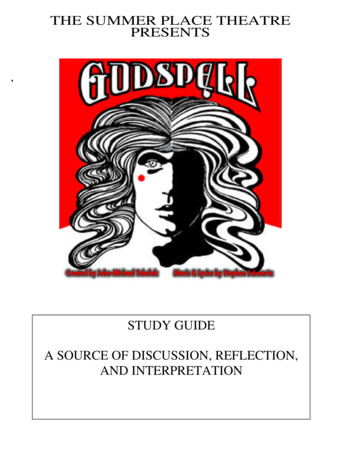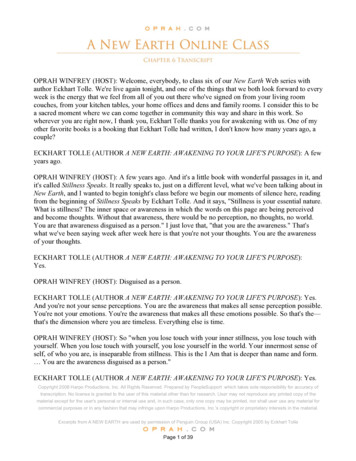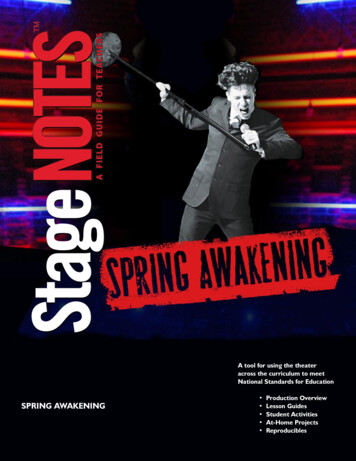
Transcription
A tool for using the theateracross the curriculum to meetNational Standards for EducationSPRING AWAKENING Production OverviewLesson GuidesStudent ActivitiesAt-Home ProjectsReproducibles
Copyright 2008, Camp Broadway, LLCAll rights reservedThis publication is based on Spring Awakening with music by Duncan Sheik, bookand lyrics by Steven Sater, direction by Michael Mayer and choreography by BillT. Jones. The content of the Spring Awakening edition of StageNOTES : A FieldGuide for Teachers is fully protected under the copyright laws of the United statesof America and all other countries with which the United States has reciprocalcopyright relations. All rights regarding publishing, reprint permissions, publicreadings, and mechanical or electronic reproduction, including but not limited to,CD-ROM, information storage and retrieval systems and photocopying, and therights of translation into foreign languages are strictly prohibited.Printed in the United States of AmericaFirst Digital Edition: July 2008For more information on StageNOTES and other theatre arts related programs,contact:Camp Broadway, LLC336 West 37th Street, Suite 460New York, New York 10018Telephone: (212) 575-2929Facsimile: (212) 575-3125Email: info@campbroadway.comwww.campbroadway.com
Table ofContentsUsing the Field Guide and Lessons.4The Story.5The Characters of Spring Awakening.6Overture to HISTORY.10History Discussion Lesson.12History Writing Lesson.13History Experiential Lesson.14History After Hours Lesson.15Overture to LANGUAGE ARTS.16Language Arts Discussion Lesson.18Language Arts Writing Lesson.19Language Arts Experiential Lesson.20Language Arts After Hours Lesson.21Overture to LIFE SKILLS.22Life Skills Discussion Lesson.24Life Skills Writing Lesson.25Life Skills Experiential Lesson.26Life Skills After Hours Lesson.27Overture to BEHAVIORAL STUDIES.28Behavioral Studies Discussion Lesson.30Behavioral Studies Writing Lesson.31Behavioral Studies Experiential Lesson.32Behavioral Studies After Hours Lesson.33Overture to THE ARTS.34The Arts Discussion Lesson.36The Arts Writing Lesson.37The Arts Experiential Lesson.38The Arts After Hours Lesson.39Spring Awakening Resources.41
Using theField GuideCamp Broadway is pleased to bring you this Spring Awakening edition ofStageNOTES , the 31st in our series. We are proud to be affiliated with this musical that sweptthe 2007 Tony Awards winning 8 awards including Best Musical. This guide has been developed as ateaching tool to assist educators in the classroom who are introducing the story in conjunction with thestage production.By using StageNOTES , you will understand Spring Awakening’s setting of 19th Century Germany(History), expand your vocabulary (Language Arts)and illuminate the human condition (BehavioralStudies). StageNOTES will also aid in your own self-exploration (Life Skills) and encourage creativethinking and expression (The Arts).The Camp Broadway creative team, consisting of theater educators, scholars, researchers and theaterprofessionals, has developed a series of lesson plans that, although inspired by and based on the musicalSpring Awakening can also accompany class study. To assist you in preparing your presentation of eachlesson, we have included: an objective; excerpts taken directly from the script of Spring Awakening;a discussion topic; a writing assignment; and an interactive class activity. The reproducible lessons(handouts) accompany each lesson unit, which contains: an essay question;a creative exercise; and an “after hours activity” that encouragesstudents to interact with family, friends, or the community atlarge.The curriculum categories offered in the SpringAwakening study guide have been informed by thebasic standards of education detailed in ContentKnowledge: A Compendium of Standards andBenchmarks for K-12 Education, 2nd Edition,written by John S. Kendall and Robert J.Marzano (1997). This definitive compilationwas published by Mid-Continent RegionalEducation Laboratory, Inc. (McREL)and the Association for Supervision andCurricular Development (ASCD) after asystematic collection, review and analysisof noteworthy national and state curriculardocuments in all subjects.The Spring Awakening study guide is foryou, the educator, in response to yourneed for a standards-compliant curriculum.We truly hope this study guide will helpyou incorporate the themes and contentof Spring Awakening into your classroomlessons.Lisa PoelleCEOCamp Broadway4
TheStory ofIt’s Germany, 1891. A world where the grown-ups hold all the cards. The beautiful young Wendlaexplores the mysteries of her body, and wonders aloud where babies come from, till Mama tells herto shut it, and put on a proper dress.Elsewhere, the brilliant and fearless young Melchior interrupts a mind-numbing Latin drill to defendhis buddy Moritz – a boy so traumatized by puberty he can’t concentrate on anything. Not that theHeadmaster cares. He strikes them both and tells them to turn in their lesson.One afternoon – in a private place in the woods – Melchior and Wendla meet by accident, and soonfind within themselves a desire unlike anything they’ve ever felt.As they fumble their way into one another’s arms, Moritz flounders and soon fails out of school.When even his one adult friend, Melchior’s mother, ignores his plea for help, he is left so distraughthe can’t hear the promise of life offered by his outcast friend Ilse.Naturally, the Headmasters waste no time in pinning the “crime” ofMoritz’s suicide on Melchior and expel him. And soon Mamalearns her little Wendla is pregnant. Now the young loversmust struggle against all odds to build a world together fortheir child.Spring Awakening is based on Frank Wedekind’scontroversial 1891 drama, which was scandalousin its day for addressing sex violence and suicide.The story, dialogue and costumes suggest the19th Century, and are perfectly wedded toa beautiful alternative pop music score byGrammy nominated singer/songwriter DuncanSheik and author and lyricist Steven Sater.The creative team also includes Tony AwardWinning director Michael Mayer and legendarychoreographer Bill T. Jones.Spring Awakening takes its inspiration from oneof literature’s most controversial masterpieces– a work so daring in its depiction of teenageself-discovery, it was banned from the stage andnot performed in its complete form in English fornearly 100 years.5
TheCharacters ofMoritzThe son of RentierStiefel and best friendof Melchior.IlsaA free spirit whogrew up withWendla, Melchiorand Moritz.OttoSchoolboy; afriend of Melchiorand MoritzTheaSchoolgirl;a friend ofWendla’sMelchiorA gifted schoolboyand a heartbrokencharacter.WendlaThe fourteenyear-old, starcrossed lover ofMelchior.
HänschenSchoolboy;a friend ofMelchiorand MoritzGeorgSchoolboy;a friend ofMelchior andMoritzMarthaSchoolgirl;a friend ofWendla’sErnstSchoolboy;a friend ofMelchior andMoritzAnnaSchoolgirl;a friend ofWendla’s
Using theLessonsEach Lesson Unit (History, LanguageArts, etc.) contains the followingLessons:Discussion:The focus is on facilitating an in-depthclass dialogue.Writing:The focus is on the expression ofthoughts in written form.Experiential:The focus is on understanding socialdynamics as well as collaboration andteamwork in small and large groups.A take-home “After Hours” lessonEach StageNOTES lessongenerally includes the followingcomponents:Objective:An overall note to the teacher outliningthe goals of the lesson to follow.From the script:An excerpt or situation from the scriptof Spring Awakening to help “set thestage” for the activity that follows.Featured Lesson Units1 History2 Language Arts3 Behavioral StudiesExercise:A detailed description and instructionsfor the activity to be facilitated in class.Teaching Tips:Direct questions teachers may use tohelp guide the students through theactivity.4 Life Skills5 The ArtsThe Standards listed throughout the StageNOTES Field Guide are excerpted from Content Knowledge: A Compendiumof Standards and Benchmarks for K-12 Education (2nd Edition) by John S. Kendall and Robert J. Marzano, publishedby Mid-Continent Regional Educational Laboratory, Inc. (McREL) and the Association for Supervision and CurricularDevelopment (ASCD), 1997.
TheGuide toTheatergoing EtiquetteIn the early part of the nineteenth century, theatricalperformances usually began at six o’clock. An eveningwould last four or five hours, beginning with a short“curtain raiser,” followed by a five-act play, with othershort pieces presented during the intermissions. Itmight be compared roughly to today’s prime-timetelevision, a series of shows designed to pass thetime. With no television or radio, the theater was aplace to find companionship, light, and warmth on acold winters evening.As the century progressed, the theater audiencereflected the changing social climate. More well-to-dopatrons still arrived at six o’clock for the full programof the evening, while half price admission was offeredat eight or eight-thirty to the working class. Thisallowed for their longer workday and tighter budgets.Still, the theaters were always full, allowing peopleto escape the drudgery of their daily lives and enjoythemselves.Because of this popularity, theaters began to bebuilt larger and larger. New progress in constructionallowed balconies to be built overhanging the seatsbelow—in contrast to the earlier style of recedingtiers. This meant that the audience on the main floor(the section called “the orchestra”) were out of theline of sight of the spectators in the galleries. As aresult, the crowds became less busy peoplewatchingand gossiping among themselves, and more interestedin watching the performance. The theater managersbegan the practice of dimming the lights in the seatingarea (called the “house lights”), focusing the attentionof the audience on the stage. The advent of gaslighting and the “limelight” (the earliest spotlights)made the elaborate settings even more attractive tothe eye, gaining the audience’s rapt attention.By the 1850s, the wealthier audiences were nolonger looking for a full evenings entertainment.Curtain time was pushed back to eight o’clock (forthe convenience of patrons arriving from dinner);only one play would be presented, instead of four orfive, freeing the audience for other social activitiesafterward. Matinee (afternoon) performances werenot given regularly until the 1870s, allowing societyladies, who would not have ventured out late at night,the opportunity to attend the theater.Now in a new millennium, many of these traditionsare still with us. The theater is still a place to “seeand be seen”; eight o’clock is still the standard curtaintime; and the excited chatter of the audience falls toa hush when the house lights dim and the stage lightsgo up, and another night on Broadway begins.You can make sure everyone you know has the verybest experience at the theater by sharing this TheaterEtiquette with them. And now, enjoy the show!Beinga Good AudRememiencemovie ber, going to. Therthethewhenyou’re are some dif eater isn’t likefeat a live perfo rent rules t going to ao keepBelievermance.in mindThe sa it or not, the actome acors canhear thusticsteaan aud actors mea hat make it p ctually heaience mns thatr you.ossiblephones ringin akes: talking they can hea for you to,rtheregis no f . That’s why unwrapping all the noise, whenood otreatsscandy, crathe mu t intermissio drink at yo you’re at a s ellhon; saveultiplex)the po r seats (eat w,pcornyNo tamunch ourlking forthe pe ing (even ifrson next to you’re just eyou)xplaininAlwayg the ps keeplot to(This ecellphoneven mseshow to tell t ans no textin and beeperhem how gre g your friend s turned offs durinat it is.Of coug therse, w.)hat theyou’reelaugh a njoying the actors like toptyour b the funny p erformance. hear is howarts, claiggestmuchSo gochactorsapat the eers and ap for the son head andcurtainwell dopgsne.call. Th lause for you , and saver faat’s their proo voritef of a job
Overture toHistoryyG e r m9a 1n18 gS e t t i tna g ethe SArt as reflection of its timeis undeniable. In the case ofSpring Awakening, the original1891 play confirms the adage.Although certainly not the firstwork to challenge the normsof its day, it was considered anultra-radical attempt in its time.Most of German society as it hadbeen up until then vanished by 1900.The pace of urbanization was rapidlyescalating. By 1910 Berlin was a major metropolitan center. People from allover Europe, many escaping war and the confines of less progressive societies,flocked there. Inventions such as the telegraph, telephone, electricity and masstransportation undreamed of one hundred years before were now reality.Along with scientific discoveries it was also a time of great change inpolitical and social thinking.Social change, confusion, and moral ambiguity were present in all areasof life – politics, technology, identity, and sexuality. Male dominationcoexisted with an active Women’s Movement. Women, too longvictims of a feudal system that made themdependent on their husbands, began toSummary of Standard forspeak out. The League of ProgressiveHistorical UnderstandingWomen’s Associations called for a boycott1. Understanding and analyzingchronological relationships andof marriage and for social acceptance ofpatterns:sex as an enjoyable behavior. Founded bynAnalyze influence of specific beliefsLily Braun and Minna Cauer, the leagueon these times. How would eventsbe different in the absence of thesesought to organize and unionize prostitutes,beliefs?promote contraception, a woman’s rightnAnalyze the effects specficto abortion and the decriminalizationdecisions had on history. Howwould things have been differentof homosexuality. Writer Emma Trossein the absence of these specificpublished her controversial brochure titleddecisions?“Is free love immoral?”.2. Understanding the historicalLily Braunperspective:Understand that the consequencesof human intentions are influencedby the means of carrying them out.nUnderstand how the past affectsour private lives and society ingeneral.nPerceive past events with historicalempathy.nEvaluate credibility andauthenticity of historical sources.nEvaluate the validity andcredibility of different historicalinterpretations.nPolitician, feminist and writer, Lily Braun was thedaughter of Prussian general. With no formaleducation, she moved to Berlin and lived financiallyindependent of her family through her writings. Themost famous is the historical literary work--Memoirsof a Socialist Woman used widely today in Women’sStudies classrooms.Minna Cauer promoted radical democratic causesthrough the feminist newspaper, The Women’sMovement. She was an avid campaigner for abortion10
rights. In 1895 she co-drafted a petition for the abolition of theLaw of Association prohibiting women from joining politicalorganizations and is credited as primary organizers of the Union ofProgressive Women’s Associations established in 1899.Raised in a middle class home much like that of the charactersin Spring Awakening, Emma Trosse was one of the first womenadmitted to attend lectures as a guest at the Friedrich WilhelmsUniversity of Berlin. There is no evidence she was ever allowed tobecome a full time student. Yet she did become a teacher. It is safeto assume as eventual head of a boarding school she was nothinglike her counterpart in the play, the rigid headmistress.Minna CauerThe expansion of education, entertainment, and access tonewsreels brought information about progressive socialmovements to the masses. Fleeing a seriously exploited landscape,large populations emigrated from the rural German countrysidesto its cities, where literacy promoted new ideas about personalfreedom. While people still respected and looked to parents forguidance, the idea that children’s perspectives on important topicsshould necessarily mimic their forbearers’ was quickly becomingextinct.Along with social and cultural reforms Germany was becominga world industrial power as well. Through the mid-19th century,Britain had dominated economically and militarily. In the late1800s, however, things were about to change. By the end of thecentury Germany, with its burgeoning military/industrial complex,had overtaken it and would soon become the greatest power onthe continent. World Wars I and II are traced by some historiansto this period.Emma TrosseWhile all of this captured the imagination of sophisticated cityresidents, older rural Germans left behind clung tightly to traditionalways. Their children, however, were very much aware thatsomething exciting was going on beyond the narrow confines oftheir village. It is in this setting that Frank Wedekind, author of theoriginal 1891 play, Spring Awakening, placed his characters. Born inMunich, a center of progressive thinking, his work often criticizedmiddle class attitudes toward sex and the repression of Germanyouth. Considered too suggestive for the theatre, the play was notperformed until 1906; large sections of it were cut by censors.The topics addressed in the play and the musical are timely eventoday—teen sex, suicide, incest and child abuse, abortion and thegeneral difficulties confronting adolescents in an adult controlledworld. If history indeed repeats itself, the story is a mirror of itstimes—then and now.11
HistoryDiscussionScriptDiscussionFrom theReporting child abuse.Act 1, Scene 8Wendla and Melchior discuss Martha’s abusive situation.ObjectiveWendlaMartha Bessell is beaten almost every evening -- the nextday, you can see the welts. It’s terrible.Really, it makes you boiling hot to hear her tell it.Lately, I can’t think about anything else.MelchiorSomeone should file a complaint.Teaching TipsWhat we are aimingfor in this lesson is todiscuss how child abuselaws have evolvedsince the 1800s, andinform students of theirresponsibility in reportingsuch behavior.ExerciseSince the 1800s child abuse have evolved considerably. Thank goodness. Children in thosedays and even beyond were considered owned by their parents, and other than socialpressure on those who committed such acts, legally, not much was done to protect the child.Students should research the history of child abuse laws in America from 1900 and takecareful notes. They should create a timeline to help organize events. As each event is listed,further research its details. These notes will be important in the discussion to follow.The earliest event in the evolution of child abuse laws found by a student will be the startingpoint of the discussion. The discussion will move forward based on the next talking pointbased on its date. For instance the first point may have occurred in 1900. The next talkingpoint might have occurred in 1901, and so on to the present.To sum up the discussion, ask students if they understand their responsibility to report childabuse. Be sure to address their concerns about false accusations.12
HistoryWritingWritingObjectiveExploring women’s rightsin two cultures.From theScriptAct 1, Scene 2Most of the history you study in junior high and high school will be American history. Notmuch about German history will be discussed. There are many parallels between the historiesof the two nations. Here’s an opportunity to get a glimpse of German culture and thewomen’s rights movement which may help you understand the significance of our own.Herr KnochenbruchLook at that. Melchior Gabor, a young man of distinct intellectual capability -Fraülein KnuppeldickThoroughly distinct.Herr KnochenbruchA young man who could be our finest pupil --Teaching TipsMost of the historyyou study in junior highand high school will beAmerican history. Notmuch about Germanhistory will be discussed.There are many parallelsbetween the histories ofthe two nations. Here’san opportunity to geta glimpse of Germanculture and the women’srights movement whichmay help you understandthe significance of ourown.Our finest, Herr Knochenbruch.Fraülein KnuppeldickAct 1, Scene 3.the young women, Anna, Thea and Wendla prattle on about marriage and boysAnnaI certainly hope your Mama approves the man Imarry.And the man I marry!TheaWendlaWell, we all know who Thea longs to marry!MarthaMelchior Gabor!TheaAnd who doesn’t?AnnaHe is rather handsome. . .ExerciseThe excerpts above reinforce how differently young men and women were perceived inthose days. The young women were raised to marry and have families while the young menwere educated for careers. Obviously women, at least in the rural areas of Germany, did notgo to school.The late 19th and early twentieth centuries were energetic times for the women’s rightsmovement. As we see from our Overture, it certainly was in Germany. But there were similarmovements going on in America at about the same time. Let’s explore a few of the moreimportant women who fought for women’s rights—and won.Tell students to pick one of the women mentioned in the Overture to History. They mayselect another German women’s rights activist if they choose. Tell them to research anAmerican women’s activist who fought for women in about the same time period—late 19th/early 20th centuries. Write an essay comparing the work of the two women titled: “Sisters inFreedom.”13
HistoryExperientialTeacher’s NoteIt is probably wiseto send a parentalpermission slip homewith students explainingthe experiment toparents.From theScriptAct 1, Scene 8Melchior writes in his journal about what it’s like to be a student.Melchior. a world where teachers -- like parents -- view us asmerely so much raw material for an obedient and productivesociety. a unified, military-like body, where all that is weakmust be hammered away.ExperientialObjective. where the progress of the students reflects back only onthe rank and order of the faculty, and therefore a single lowmark can be seen as a threat to --Living the life of a19th–century Germanstudent.ExerciseTeaching TipsLife for students today isnothing like it was “backthen.” Modern attitudesabout education havedrastically changed theclassroom landscape.How do you think youwould handle life in a19th century classroom?Everyone, including the teacher, will be involved in this unusual experiment.Life for students in German schools was hard, to say the least. Rigid teaching methods andsometimes unreasonably high expectations were the norm. Take some time to do extensiveresearch on the educational environment of classrooms in the 19th century. When theclass has finished, get together and combine all of the information found. As a class theyshould develop a profile that can be easily implemented. Everyone reads the final profile andunderstands their roles.With the teacher as school master or mistress, spend a period learning the way studentsat that time might learn the material. Since corporal punishment in those days was a fairlycommon activity, teachers, of course, may only simulate the striking of errant students.Teachers may use the simulated corporal punishment as they see fit and based on informationfound by students in their research.Aren’t you lucky to be a student today!?14
HistoryAfter HoursTeaching TipsChallenge #1Students take anopportunity to learnmore about Germanand German-Americanhistory.Getting To Know “The Iron Chancellor”For hundreds of years, Germans lived in many separate states, one of the most powerful ofwhich was the kingdom of Prussia. During the late 1800’s, Otto von Bismarck, the primeminister of Prussia, united most of these states and cities under Prussian leadership. Expandyour history knowledge. Read up on Bismarck and get to know who he was and what hemeant to Germany.Challenge #2Who Were They?Daniel PastoriusJohn Peter ZenglerGottfried DudenAugust FollenCarl SchurzFranz SigelPeter OsterhausFriedrich HecklerAdalbert VolckGottfried KinkelJohann MostAugust Spies,Adolph FisherLouis LinggGeorge EngelJohn Peter AltgeldJohann SuterOscar HammersteinJoseph SeligmanFrederick Weyerhaeuser15
Language ArtsOverture toBenjamin FranklinWedekind, orFrank Wedekind,ermanwas born in 1864ertain Hannover,heeGermany but grewin thup in Switzerland.sHis father was adoctor and beforeher marriage,Wedekind’smother was an actress. Although Wedekind playedan influential role in the development of Germanepic theatre, and is considered a father of theatricalexpressionism, his work is not part of any particularschool. He was, however, credited thenand now with being one of the first literaryfigures to identifyand write aboutSummary of Standard forLanguage Artssexuality as a majorWritingdriving force in theDemonstrates competence in thehuman condition.general skills and strategies of theGT1800nwriting processDemonstrates competence inrewriting, drafting and revising,editing and publishingnDemonstrates competence in thestylistic and rhetorical aspects ofwritingnUses grammatical and mechanicalconventions in writtencompositionsnGathers and uses information forresearch purposesnReadingDemonstrates competence in thegeneral skills and strategies of thereading processnDemonstrates competence in thegeneral skills and strategies forreading a variety of literary textsnDemonstrates competence in thegeneral skills and strategies forreading a variety of informationaltextsnListening and SpeakingDemonstrates competence inspeaking and listening as tools forlearningnAfter a number of jobsin which he traveledabout, Wedekindlanded in Munich at atime of renewed interestin the dramatic arts. It wasthe perfect environment forhis controversial Spring Awakening,written between 1890 and 1891while Wedekind was in his latetwenties. Chronicling the lives ofGerman teenagers attempting todiscover their sexual identities,the play met with resistance fromGerman producers and was notstaged until some time later, heavilycensored.As the rigid school mistress stateswhen “punishment” of waywardFrank Wedekind16
teens comes up, “I cannot stand the creepingsensuality of these liberal times.”The play also focused on other issues plaguing teenstoday: sex, abortion, coming into ones own and thestruggle that exists between teens and authorityfigures.Bertolt BrechtEpic theatre earned its name by using cleardescription, a reporting style, choruses and projectionsas a means of communicating with audiences. Itrenounced the romanticism of earlier theatre andpresented characters who represented different sidesof an argument. The audience was invited to draw itsown conclusions about the situations presented in amore detached “scientific” way—an approach fullydeveloped in the mid 20th century by noted Germanplaywright, Bertolt Brecht. He called the scientificapproach the “alienation effect.” Both Wedekind andBrecht used unrealistic sets and comedy to soften theharsh realities of events presented in their plays.The ever-present anxiety of the characters in SpringAwakening foreshadowed the expressionist movementin German theatre which became prominent in theearly 20th century. Involving a distortion of emotion,the concept of expressionism was widely present inEuropean art movements of the time. Edvard Munch’s“The Scream” is a good example of the expressioniststyle.The Scream by Edvard MunchSpring Awakening also incorporates an element of epictheatre called “breaking the fourth wall,--an imaginarypartition at the front of the stage separating the actorsfrom the audience. Theatrically speaking, “the forthwall” is meant to symbolize the barrier between theworld of fiction on stage and the audience. When anactor “breaks the fourth wall” he or she speaks to theaudience directly. These techniques are regularly usedin today’s sitcoms filmed before live audiences. In theshow “Malcolm in the Middle”, the main characteroften speaks directly into the camera while othercharacters seem not to hear him. One actor can alsoplay several rolls, as the two “adults” in the musicalversion play mothers, fathers, headmaster and mistressof the school. All of these techniques are present in1800s German theatre, which one can safely assumewas light years ahead of its time.17
Language ArtsDiscussionScriptDiscuss
This publication is based on Spring Awakening with music by Duncan Sheik, book and lyrics by Steven Sater, direction by Michael Mayer and choreography by Bill T. Jones. The content of the Spring Awakening edition of StageNOTES : A Field Guide for Teachers is full

